| Home | Nature Weekly Index |
14 May 2017 | Jumping Plant Louse | Jackfruit Psyllid | Paurocephala species |
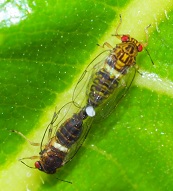
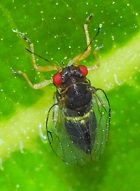 This was my second post on jumping plant louse (superfamily Psylloidea) after the one related to the
hairy leaf galls on fig tree. While checking on two hoppers
(Ptyelinellus praefractus and
Tartessus ferrugineus) on a
Jackfruit Tree (Artocarpus heterophyllus)
last week, I came across a group of 5 tiny insects, including a mating pair, of about 2 millimetres long on a
leaf. They looked like mini cicada with red coloured eyes. It was quite clear that they were a type of hoppers.
This was my second post on jumping plant louse (superfamily Psylloidea) after the one related to the
hairy leaf galls on fig tree. While checking on two hoppers
(Ptyelinellus praefractus and
Tartessus ferrugineus) on a
Jackfruit Tree (Artocarpus heterophyllus)
last week, I came across a group of 5 tiny insects, including a mating pair, of about 2 millimetres long on a
leaf. They looked like mini cicada with red coloured eyes. It was quite clear that they were a type of hoppers.
After narrowing the possible candidate to jumping plant louse (psyllid) from the superfamily Psylloidea (lerp insects), the closest I got to Paurocephala psylloptera (Mulberry Psyllid). Pictures of Mulberry Psyllid from a Taiwan website resembled the ones that I saw except for the red eyes. There were a few Mulberry shrubs (Morus alba) near the Jackfruit Tree but not a single of this psyllid was on it. Since I did not have an identity down to the species level, I will call it Jackfruit Psyllid for the time being.
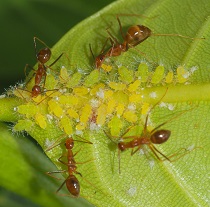
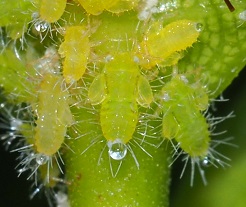
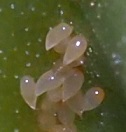 I recalled seeing some hairy greenish-yellow psyllid nymphs a week before this sighting on another Jackfruit
Tree nearby. I had a feeling that the nymphs were related to this Jackfruit Psyllid. With that suspicion, I made
another 2 visits to this Jackfruit Tree to look for more clues. The effort led to the confirmation of my
suspicion. Indeed, those were the nymphs of the Jackfruit Psyllid. I had even located the eggs. Both eggs and
nymphs were guarded by
Yellow Crazy Ant (Anoplolepis gracilipes).
I recalled seeing some hairy greenish-yellow psyllid nymphs a week before this sighting on another Jackfruit
Tree nearby. I had a feeling that the nymphs were related to this Jackfruit Psyllid. With that suspicion, I made
another 2 visits to this Jackfruit Tree to look for more clues. The effort led to the confirmation of my
suspicion. Indeed, those were the nymphs of the Jackfruit Psyllid. I had even located the eggs. Both eggs and
nymphs were guarded by
Yellow Crazy Ant (Anoplolepis gracilipes).
In an article published in 2006 Jackfruit Tree was investigated on its relationship to the more well-known Asian citrus psyllid, Diaphorina citri but such relationship did not seemed to exist [1]. Besides this article, there was no other report on sighting of specific psyllids on the Jackfruit Tree. A report back in 2002 on the Old World jumping plant-louse genus Paurocephala [2] did indicate the association of this species with the plant family Moraceae. Jackfruit Tree happened to be from this family. Furthermore, Mulberry Psyllid was first reported on the Mulberry Tree [3], also a member of the Moraceae family.
This psyllids had caused quite a bit of damage to the Jackfruit tree, specifically the curling and deformation of the young leaves. The eggs were laid on the young leaves and the hatched nymphs sucked the plant sap from the leaves which resulted in the deformity of the leaves.
Reference:
[1] Pena JE, Mannion CM, Ulmer BJ, HalbertSE. Jackfruit, Artocarpus heterophylus, is not a host of Diaphorina citri (Homoptera: Psyllidae) in Florida. Florida Entomologist 2006;89(3):412-413.
[2] Mifsud D, Burckhardt D. Taxonomy and phylogeny of the Old World jumping plant-louse genus Paurocephala (Insecta, Hemiptera, Psylloidea). J Natural History 2002;36(16):1887-1986. | Abstract |
[3] Hsieh FK, Chen S. Morphology and bionomics of the Taiwan mulberry psyllid Paurocephala psylloptera Crawford. Plant Prot Bull 1977;19:37-46.